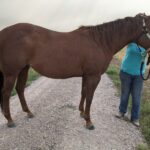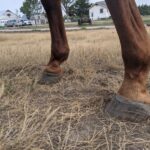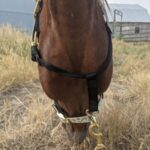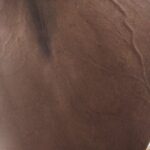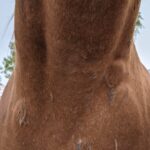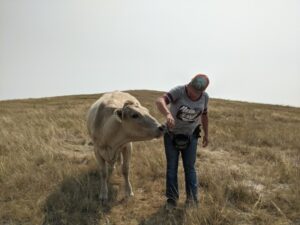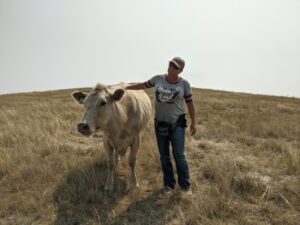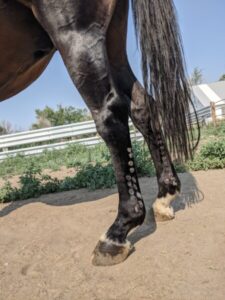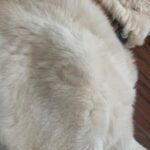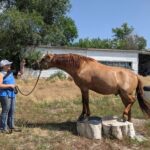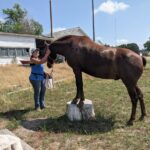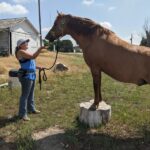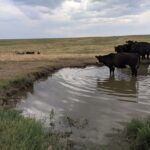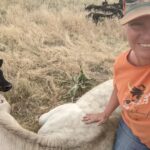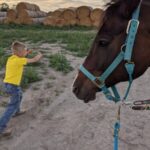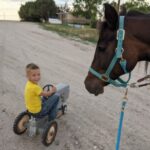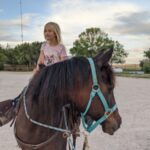Horse Whorls, Lop Sided
Ghost
Hypermobility, for whorl page
Roping Lessons
Rusty, the worlds greatest roping horse, has been busy giving lessons to a you aspiring roper.
They’re doing it sporting her new cinch from JR Custom Cinches and looking great doing it! https://www.facebook.com/JRCustomCinches
New Whorls? for the whorl page
Whorl develop in the womb as the horse develops. We know that and we know that this is why we can use them to tell us about the inside of the horse, or any other creature with hair. The skin and hair follicles are made right alongside the brain and muscle.
Animals are born with the whorls that they will have.
Or are they?
This dog is an anomaly in so many ways. Apparently he didn’t feel the need to follow the rules in this anymore than he has in the rest of his life. Diagnosed with a bone tumor at eleven he was given no chance of survival, due to his age there was no likelihood of treatment succeeding.
Told to take him home and make him comfortable his people did exactly that. Due to that love and care he is still going strong.
The other thing that he is doing is developing a whorl!
Directly over the location of the bone tumor a whorl has grown in the hair over the last few weeks.
Whorls aren’t supposed to be able to appear after an animal is born. It just isn’t done.
The hair is directly connected to the muscle underneath, to the body. Everything is connected, which seems obvious but is constantly being driven home to me. Why shouldn’t changes in the underlying structure cause changes in the way the hair grows?
This deserves a scientific paper written about it. All it will get is its own post. This is a very big deal. People often ask if their horses whorls could possibly be changing. I can no longer say no with confidence.
Ball Challenge
We are doing a ball challenge over in the Academy. Everyone who wants to contribute a video of their horse playing ball will be included in a group video for all of us to share.
I was able to convince my daughter to come play with me. She has been having fun stealing my gopro and making then editing videos of her adventures around the farm. I thought she might like to edit this one and maybe she will do her own take on it. For now this is mine.
Company
We had company over to play yesterday!
A neighbor girl came over. She has her own horses and is a very good horseperson. We worked on some ground work with Heildorf. Touched on the basics of starting clicker training, ground manners, targeting, that sort of thing. Then she went to playing with Heildorf. They played with smile, Spanish walk, and pedestal work.
She was doing such a great job I threw her up on Rusty for even more fun. We practiced riding basics, good hand position, leg yield, body position to get a good back without the reins. She did great. Rusty gets frustrated easily but was very patient with us.
It was a fun day and I hope that I get another play date soon. It’s no fair that they are mostly limited to the children 😉
Trust
I went out to check the tank in the cows pasture last week. The flies have been awful this year. Most of the herd was huddled together swatting flies, in or out of the pond.
All of them except Ghost. She isn’t really included in the herd. She came running up to me as I shut the 4wheeler off, begging me to help her.
I ran my hands down her back, brisket, and legs, smashing as many flies as I could. Rubbing away the pain of the fly bites. Scratching where it itched. She knew I would help her. She trusts me to take care of her and do my best to fix whatever problems she had.
Two of the horses wandered off the other day. I had let them both out to graze, together instead of only one at a time like usual. There is only one unfenced path out of the yard. I don’t worry a whole lot about them leaving. I don’t think there would have been a problem but those same flies, driving everything crazy. They wandered farther than usual and got themselves on the wrong side of an electric fence.
They were not happy and wanted back. They wanted back bad.
As soon as I realized what was going on I rushed to save them. In sandals and carrying one halter because I didn’t want to take the time to grab another. Ducking under the fence I called and they came running to me, begging to be saved. They came with such enthusiasm I thought my toes would never survive the saving. They knew they could trust me to take care of them and do my best to fix whatever problems they had.
With one horse haltered and the other following close on his heels we dropped the fence they followed me across the scary wire and back to the others.
Trust is such an important part of our relationships with our animals. Do they know that we will only do what is best for them or are they more afraid of us than of the scary things in life?
If we can get our animals to do what we want because they fear us then we wont be able to get them the help they need when the other things are scarier. If we can get our animals to do what we ask because they want to and they trust us to take care of them, they will run to us, instead of away, when they need help.
Riding With +R, For The Academy
The kids wanted to ride last night. It’s been awhile and took quite a bit of time to get saddle and cinches, and children sorted.
It made me think through all the steps we take in the process of getting ready to ride. Thinking of +R as something that we do once in the saddle to help improve communication as we ride is limiting and only a small piece of the picture.
We’ve all heard the stories of horses who blow up when the cinch is tightened, as in holding their breath so the cinch stays loose, but also the stories of horses who blow up as in throw themselves to the ground or over backwards. Then there are the ones who wont stand at the mounting block or walk off as the person swings into the saddle. We can use +R to help with those issues too.
First and foremost making sure there are no pain issues and that we are tightening the cinch/girth slowly and politely is the most important. Once those are taken care of we can add a click and a treat to make the whole saddling process more enjoyable.
To start with I like to click and treat my horse as I add each piece of tack. Set the blanket on their back, click treat. Saddle, click treat. Check and adjust the cinch on the off side, click treat. Tighten cinch in slow increments, click and treat for each adjustment.
This may seem like a lot of clicking for one small action. I have horses who came with very bad associations with being saddled and ridden. With a few extra treats we can change that association from bad to something they look forward to or at least tolerate willingly.
I want my children to learn to get on and off by themselves and I want my horses to line up to the mounting block and wait patiently and willingly for me. To help with both of these I never skip a treat when getting on. Line up to mounting block, click treat. Swing into the saddle, or no saddle, click treat. My kids struggle into the saddle, shove cookies in as fast as the horses can eat them through the whole mounting process. This not only teaches them to stand happily for mounting but keeps them from walking off because they are waiting for the treat they know is coming!
Then there are all the ‘scary’ things you come across as you ride. For me it is usually children, both in the saddle and on the ground. They bounce and flop and make lots of noise. If we add a treat to go with all those scary things they do the scary things quickly change from scary to a sign that a treat will soon be coming.
It is tins of fun and a great thing to refine our riding as much as we can. It is also important not to over look the mundane things along the way as we get there though. Don’t skimp on the cookies as you get to the riding part.
